全文HTML
--> --> -->为了获得高效稳定的高功率微波输出, MILO工作点一般设计在基模(TM00模)的π模, 但器件运行初期仍然容易有不同程度的模式竞争现象出现[11-21]. 由于MILO中波束互作用区通常采用同轴盘荷波导作为其慢波结构, 因此, 从同轴盘荷波导中几个可能被相对论电子束激发的低阶模式(TM00, TM01和HEM11模)与电子束之间的色散关系入手, 简要分析了三种类型的模式竞争的特点、产生的可能原因以及削弱方法, 具体包括基模TM00模相邻纵向模式之间的竞争、高阶对称模TM01与基模之间的竞争以及非对称模式HEM11与基模之间的竞争, 为磁绝缘线振荡器运行过程中出现的竞争模式的识别和输出性能的优化提供参考. 在此基础上, 给出了一种稳定紧凑型L波段MILO的物理模型并利用全电磁三维粒子程序进行了数值模拟, 重点对起振阶段的模式竞争问题进行了分析.
同轴盘荷波导的纵向中心截面(即过轴线的纵向截面, 以下简称纵向截面)和横截面如图1所示, 包括阴极、阳极叶片和阳极外壳, 它们均为金属导体, 其中p为慢波结构的周期长度, 整个结构为轴对称的圆柱结构.
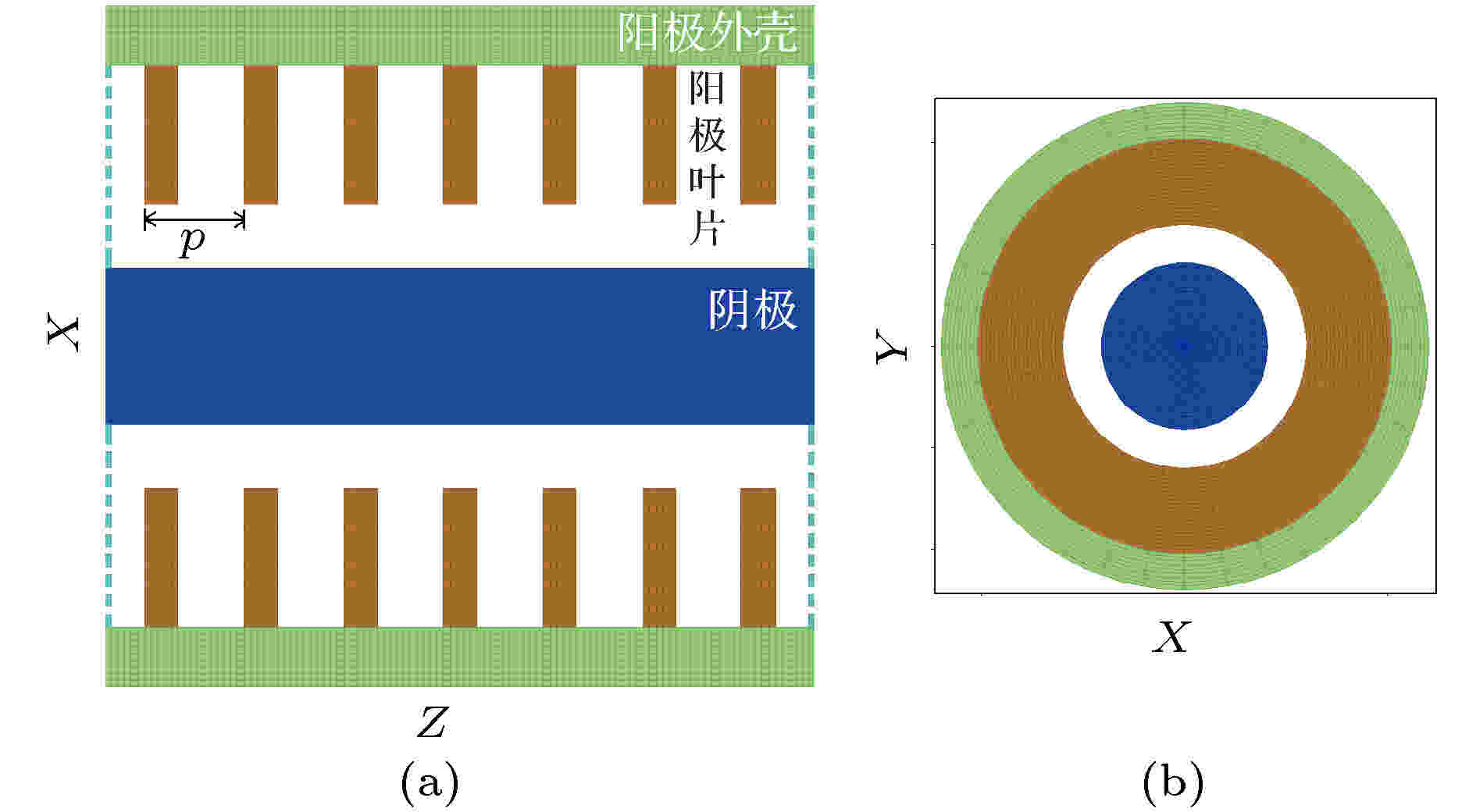 图 1 同轴盘荷波导的结构示意图 (a) 纵向中心截面; (b) 横截面
图 1 同轴盘荷波导的结构示意图 (a) 纵向中心截面; (b) 横截面Figure1. Schematic drawings of the coaxial disk-loaded waveguide in (a) Axial and (b) radial cross section
利用电磁场模拟程序, 计算了上述同轴盘荷波导中TM00模、TM01模和HEM11模的色散曲线, 具体计算方法可参考文献[4,20,22], 其中阴极半径为4.0 cm, 阳极叶片和阳极外壳的内半径分别为6.0 cm和10.0 cm, 周期长度p为3.0 cm, 电子束电压为500 kV, 具体结果如图2所示. 图2中还给出了电子束和真空中光束的色散曲线,


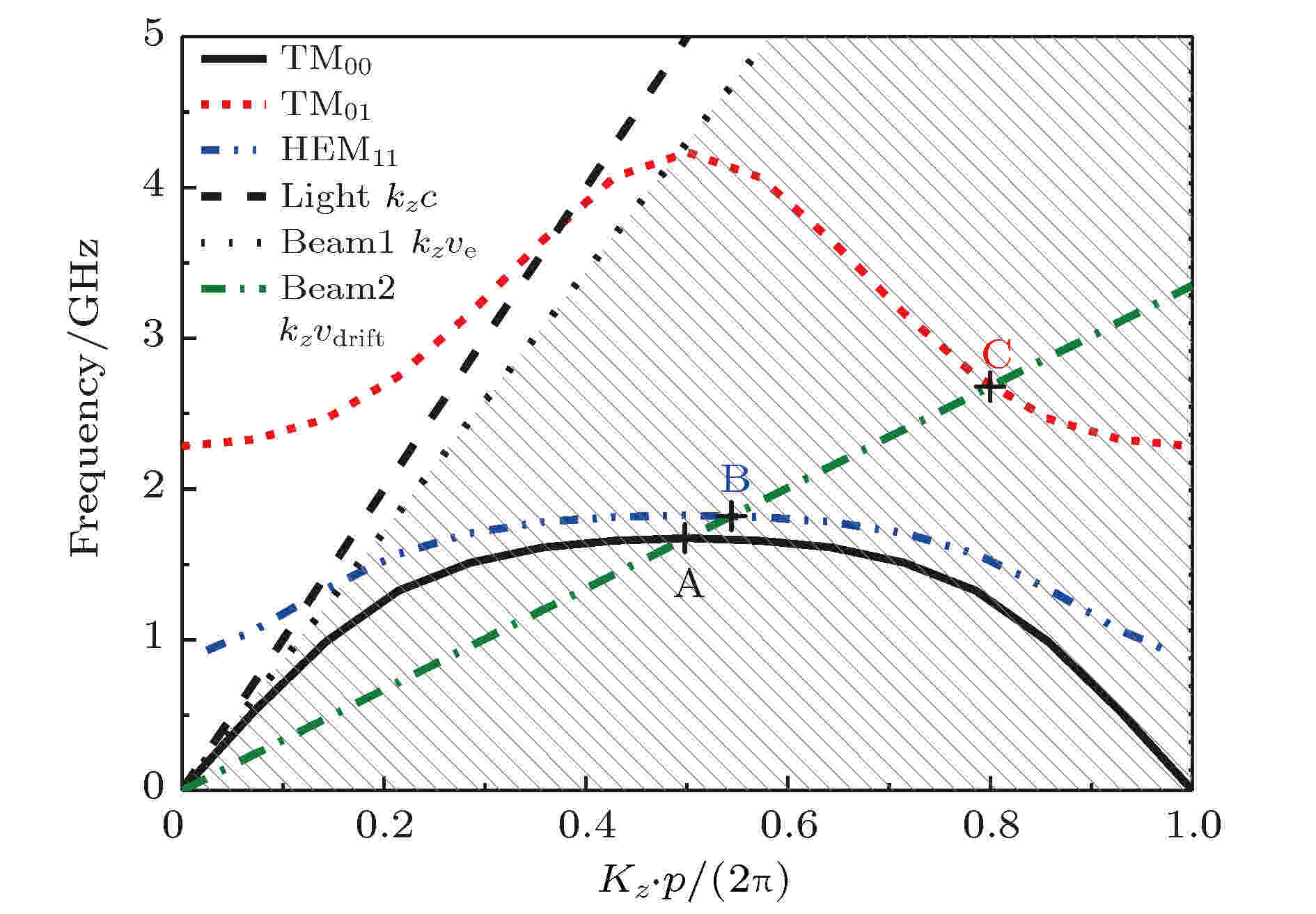 图 2 同轴盘荷波导中TM00模、TM01模、HEM11模以及电子束和光束的色散关系图
图 2 同轴盘荷波导中TM00模、TM01模、HEM11模以及电子束和光束的色散关系图Figure2. The uncoupled dispersion curves of the coaxial disk-loaded waveguide (TM00, TM01 and HEM11), and the dispersion lines of the electron and light beam.
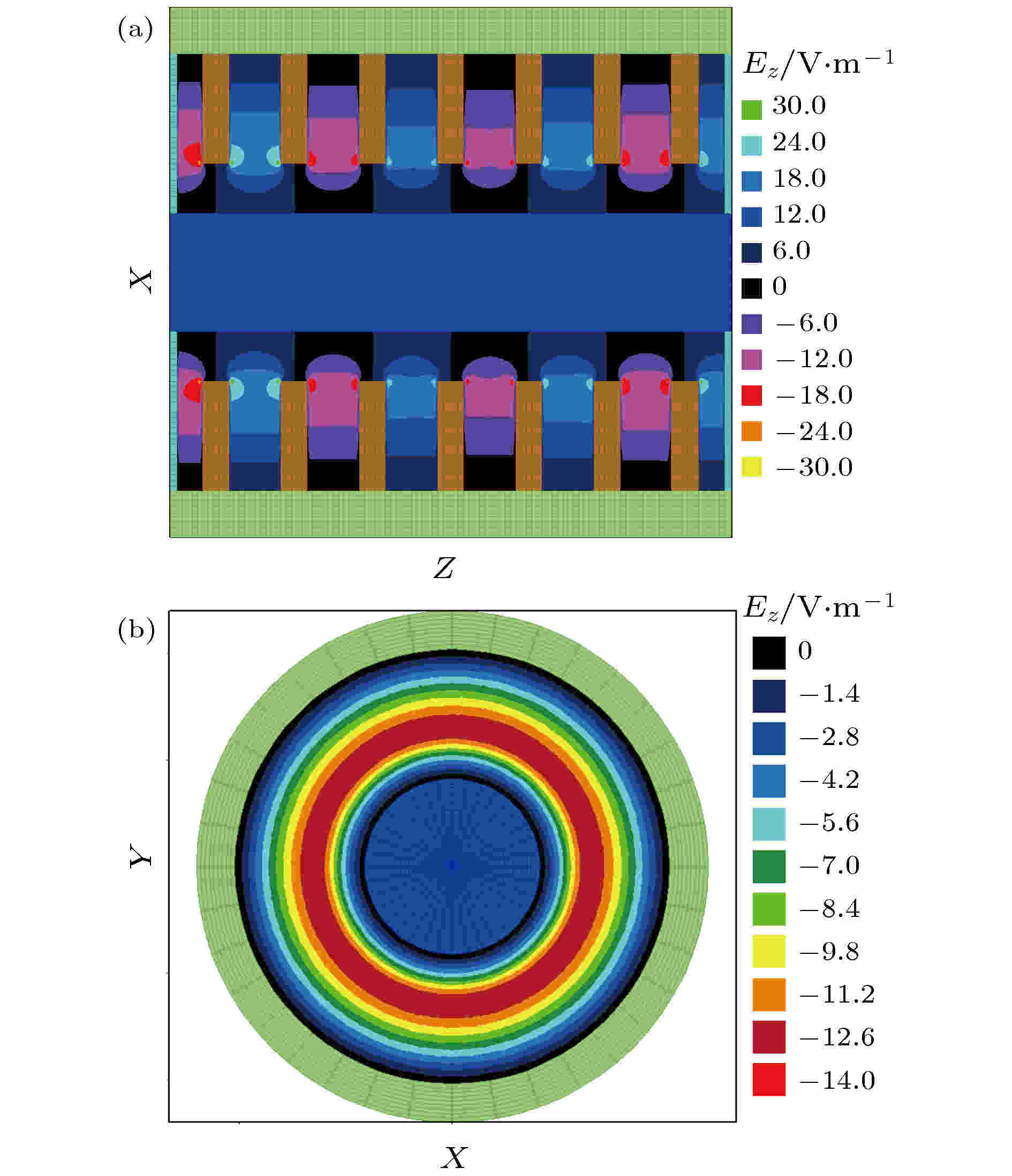 图 3 同轴盘荷波导中TM00(π模)的轴向电场在(a) 纵向中心截面和(b) 横截面的等高图
图 3 同轴盘荷波导中TM00(π模)的轴向电场在(a) 纵向中心截面和(b) 横截面的等高图Figure3. The contour plots of Ez of the TM00 (π mode) in the coaxial disk-loaded waveguide in the (a) Axial and (b) radial cross section.
2
2.1.基模TM00不同纵向模式的竞争
对于来自基模(TM00)非π模的竞争, 由图2可以看到, 可能参与竞争的纵向模式一般是与π模(点A)较接近的模式, 如(N–1)π/N, N为互作用区阳极腔的个数, 即慢波结构的周期数. 由于是基模之间的竞争, 因此竞争模式的电磁场分布仍然具有轴对称性(图3(b)), 共振频率略低于工作点π模对应的频率. 该竞争模式初期可能先于π模被激发, 一段时间后, 可能被π模抑制.已经知道, 在MILO中, 从阴极发射的电子束的能量分配到了径向和轴向两个方向. MILO设计时, 要求电子的平均漂移速度约等于基模TM00模的相速度. 但由于电子的动能与径向位置相关, 因此, 磁绝缘尚未完全形成前, 电子速度沿径向连续变化, 电子束色散线可扫过如图2的阴影部分[15,16]. 电子束色散线与TM00模的色散曲线将产生一系列交点, 从而可能激发起TM00模的含π模在内的其他纵向模式. TM00模的纵向模式之间的竞争已经在实验上观察到且被证实[17,18].
通过合理选取阳极腔的个数来控制模式隔离度, 或者选取合适的阳极叶片半径, 尤其是提取腔叶片的半径来调整束波互作用腔的品质因数, 可以削弱或者抑制TM00模的纵向模式之间的竞争.
2
2.2.高阶模TM01与基模的竞争
对于基模与高阶模TM01之间的竞争, 此时竞争模式TM01的电磁场分布也具有轴对称性, 只是轴向电场沿径向正负交替一次, 如图4所示. 由色散关系图2可以看到, 点C为电子束和TM01模色散曲线的交点, 其对应的共振频率远高于点A对应的频率, 且交点位置随电子束纵向速度(电压)变化相对较为敏感, 因此激发难度相对较大. 但由于此时束波共振点对应的本征模的群速度小于零, 如果器件品质因数较高或者互作用区较长, 器件运行初期有可能被激发.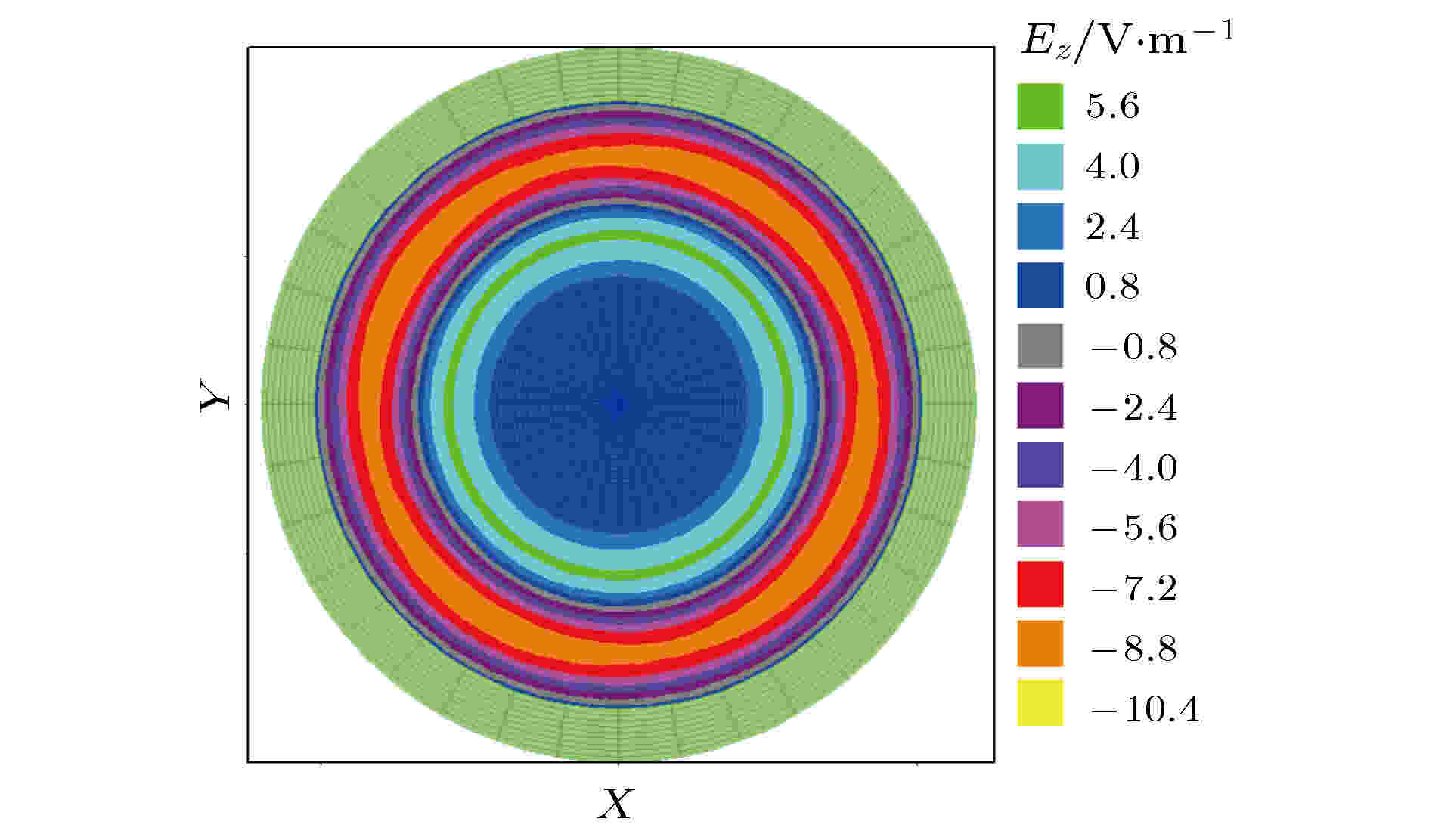 图 4 同轴盘荷波导中TM01的轴向电场在横截面的等高图
图 4 同轴盘荷波导中TM01的轴向电场在横截面的等高图Figure4. The contour plots of Ez of the TM01 mode in the coaxial disk-loaded waveguide in the radial cross section.
通过调节阳极叶片的半径进而降低束波互作用腔的品质因数, 或者通过增加负载电流强度缩短MILO达到磁绝缘状态的时间, 都可能有效抑制TM01模式的起振和放大.
2
2.3.非对称模式HEM11模与基模的竞争
对于非对称模式HEM11模与基模的竞争, 由图2可以看到, HEM11各纵向模式的频率仅略高于与之对应的TM00模的频率, π模附近的频率相差最小(图中点A和点B). 其中, HEM11模在点B处对应的纵向电场在纵向和横向截面分布的等高图如图5(a)和图5(b)所示. 可以看到, HEM11模的轴向电场Ez不再具有轴对称性, 而是沿角向正负交替一次.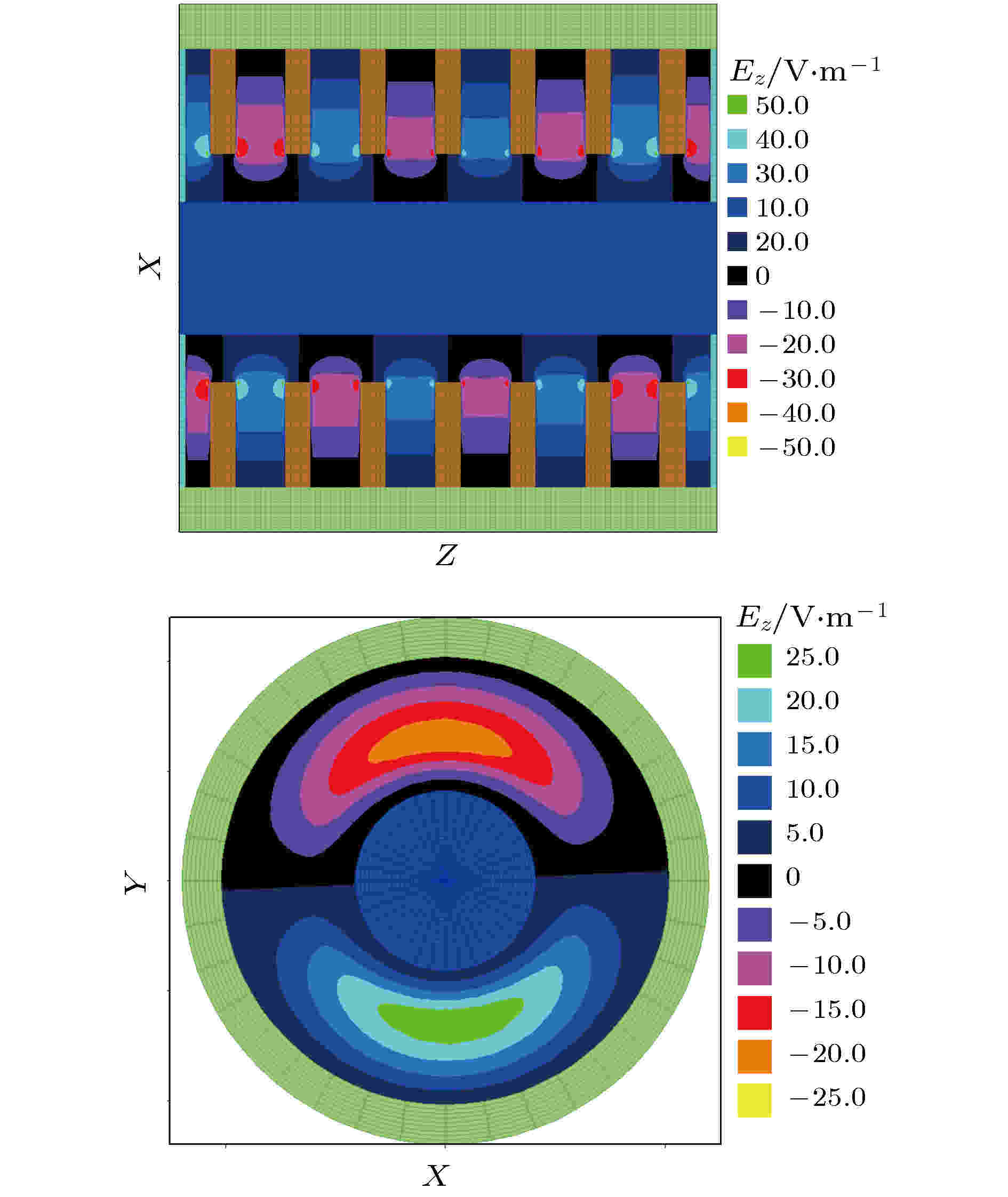 图 5 同轴盘荷波导中HEM11(π模)的轴向电场在 (a) 纵向中心截面和(b)横截面的等高图
图 5 同轴盘荷波导中HEM11(π模)的轴向电场在 (a) 纵向中心截面和(b)横截面的等高图Figure5. The contour plots of Ez of the HEM11(π mode)in the coaxial disk-loaded waveguide in the (a) Axial and (b) radial cross section.
已有研究表明: 任何小的结构非对称或者电子发射的非均匀, 都可能在器件运行初期激发HEM11模, 且起振较快, 在器件运行初期很难完全抑制[19-21]. 由于MILO慢波结构包括反射区、互作用区和提取输出区, 在这些区域, 阳极叶片半径各有差异, 加上输出区还有支撑杆, 导致与TM00模的频率接近的HEM11模容易被激发
尽量保证器件结构的对称性和阴极电子发射的均匀性, 尽管不能够完全消除这种竞争模式, 但可以最大程度地缩短模式竞争的时间和减小竞争模式的强度.
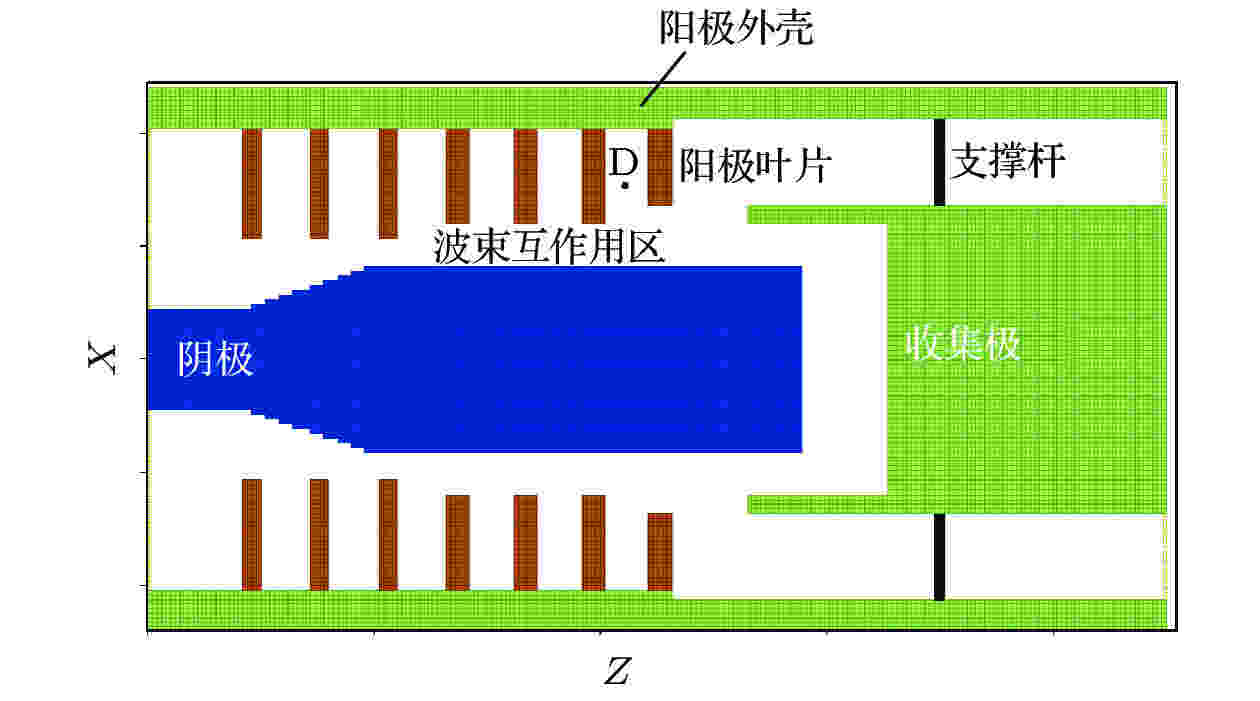 图 6 紧凑型MILO纵向截面示意图
图 6 紧凑型MILO纵向截面示意图Figure6. Schematic drawing of the compact MILO in the axial cross section.
2
3.1.冷腔模拟和分析
为了计算波束互作用区中的共振频率, 将上述MILO的互作用区两端封闭, 同时沿z方向在第四和第五叶片之间加载一个短脉冲宽频信号来激励电磁场振荡. 图7给出了上述激励信号在MILO互作用区中点D的位置激发出的电场频谱图. 由图7可以看到: 在容易被激发的频率中, 较低的两个频率分别为1.61和1.77 GHz.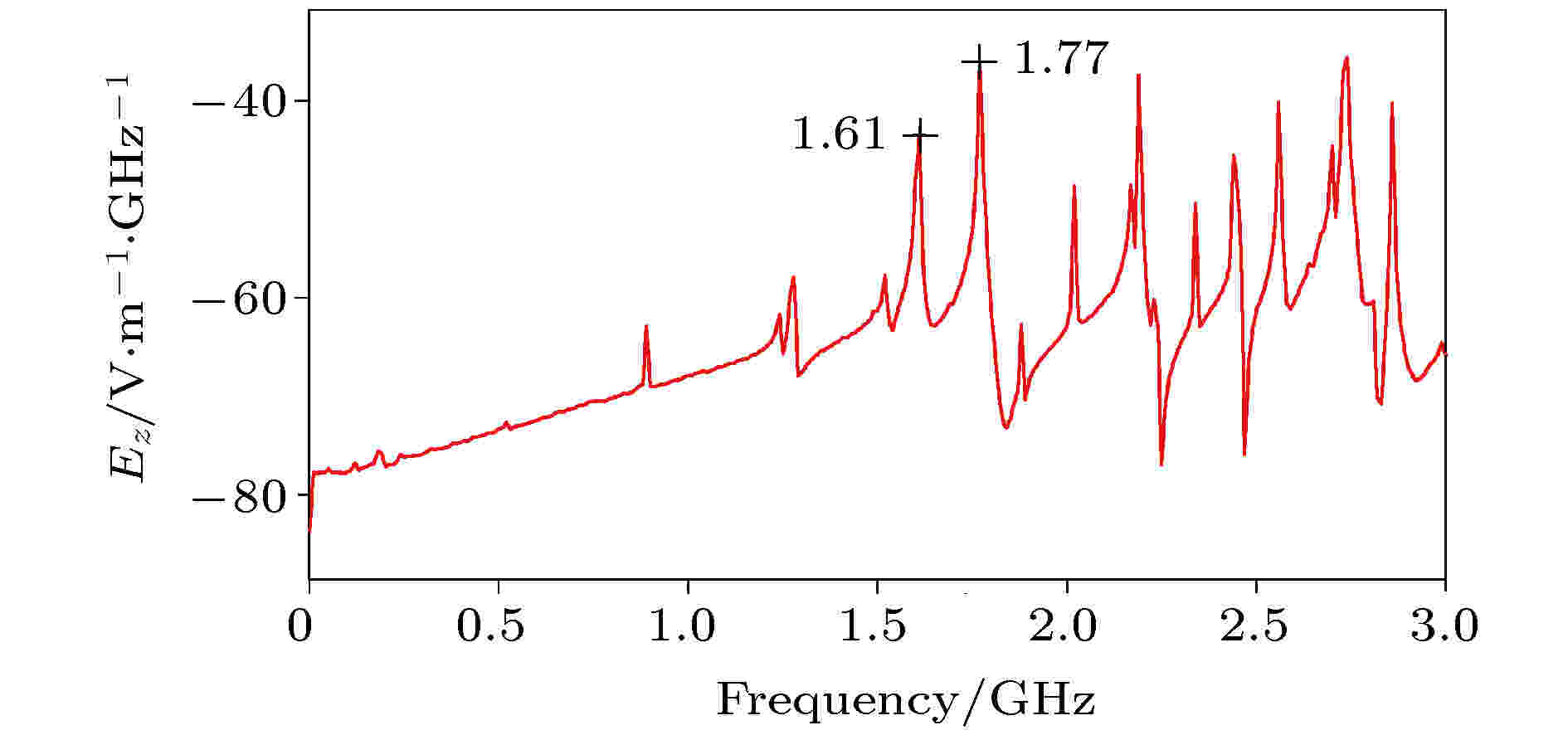 图 7 短脉冲宽频信号激发后MILO互作用区中点D处电场的频谱图
图 7 短脉冲宽频信号激发后MILO互作用区中点D处电场的频谱图Figure7. The oscillation frequency of the Ez stimulated in cold cavity at point D.
图8(a)、图8(b)和图9(a)、图9(b)分别给出了频率分别为1.61和1.77 GHz时对应的纵向电场在XZ和XY两个截面分布的等高图. 结合前面的分析, 可知这两个频率对应的电磁场模式分别是TM00模和HEM11模的π模. 由此可见, 与基模TM00模相同, 对于HEM11模, 与电子束容易产生相互作用的模式也是π模.
 图 8 频率为1.61 GHz的纵向电场在 (a) 纵向和(b) 横向截面等高图
图 8 频率为1.61 GHz的纵向电场在 (a) 纵向和(b) 横向截面等高图Figure8. The contour plots of Ez with the frequency of 1.61 GHz in (a) The axial and (b) the radial cross section.
 图 9 频率为1.77 GHz的纵向电场在 (a) 纵向和(b) 横向截面的等高图
图 9 频率为1.77 GHz的纵向电场在 (a) 纵向和(b) 横向截面的等高图Figure9. The contour plots of Ez with the frequency of 1.77 GHz in (a) The axial and (b) the radial cross section.
2
3.2.热腔的数值模拟及物理分析
下面, 我们利用全电磁三维粒子模拟程序对给出的如图6所示的L波段MILO的输出性能进行数值模拟, 同时考察初始阶段的模式竞争情况, 其中注入的电子束的平均电压约为510 kV, 对应的电功率约为32.8 GW.图10(a)—(d)和图11(a)—(d)给出了阳极腔内D点电场和磁场随时间的变化曲线及针对不同时段的FFT变换图. 由图10(a)和11(a)可以看到, 辐射场8.0 ns左右开始起振, 大约22.0 ns达到饱和, 其中在8.0至14.0 ns之间, 存在一个小的峰值. 对电磁场按时间分段做FFT变换, 可以得到, 全时段(0—50 ns)的电磁场的中心频率约为1.6 GHz, 但是可以看到有略高于该频率的小峰值, 提示有一定强度的竞争模式; 初期(8—14 ns)的电磁场的频率约为1.7 GHz, 稳定后(> 14 ns), 电磁场的频率约为1.6 GHz, 频谱比较纯, 略高于该频率的小峰值没有出现. 可见, 在起振后的初始阶段, 存在明显的模式竞争; 大约过10 ns左右, 竞争模式被抑制.
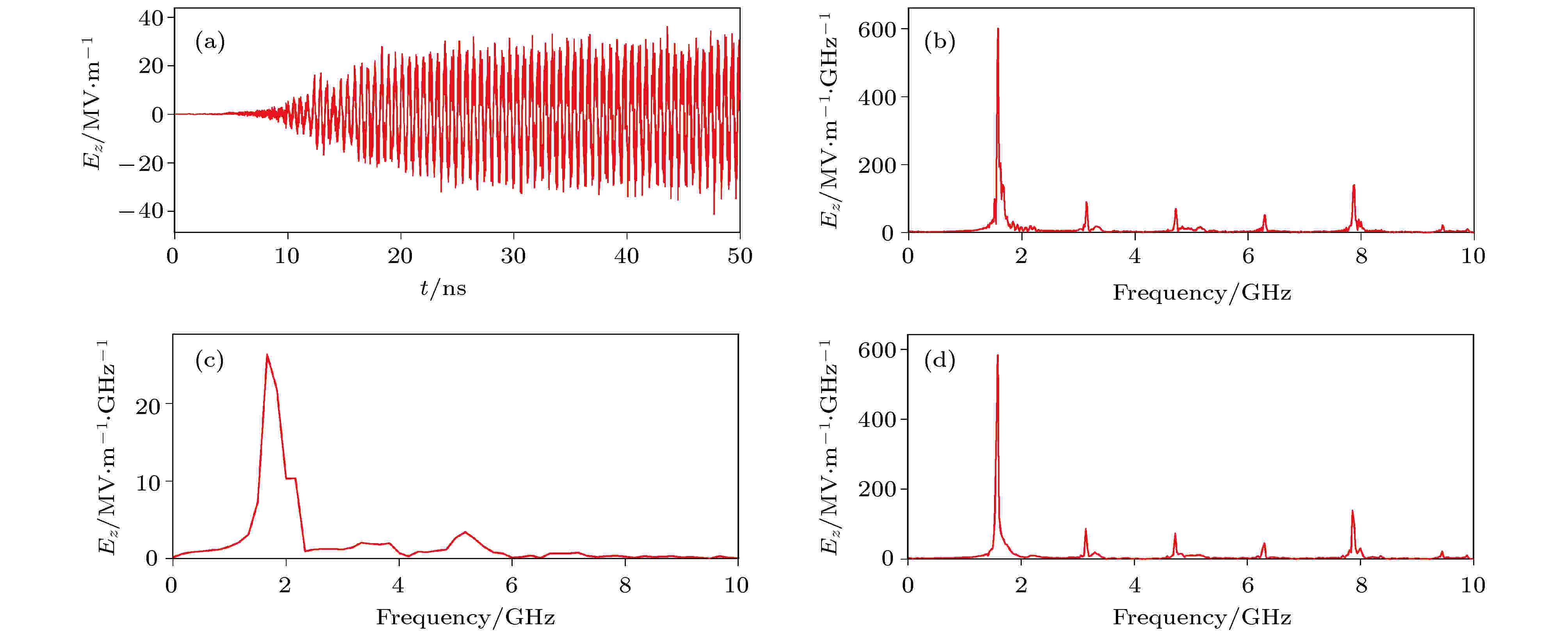 图 10 (a) 阳极腔内观察点D的电场Ez随时间的变化曲线及不同时间窗口(b) 0?50 ns, (c) 8?14 ns和(d) 14?50 ns的FFT变换图
图 10 (a) 阳极腔内观察点D的电场Ez随时间的变化曲线及不同时间窗口(b) 0?50 ns, (c) 8?14 ns和(d) 14?50 ns的FFT变换图Figure10. (a) Variations of Ez with time at the observation point D in the anode cavity; the corresponding Fourier transform with different time intervals: (b) 0?50 ns; (c) 8?14 ns; (d) 14?50 ns.
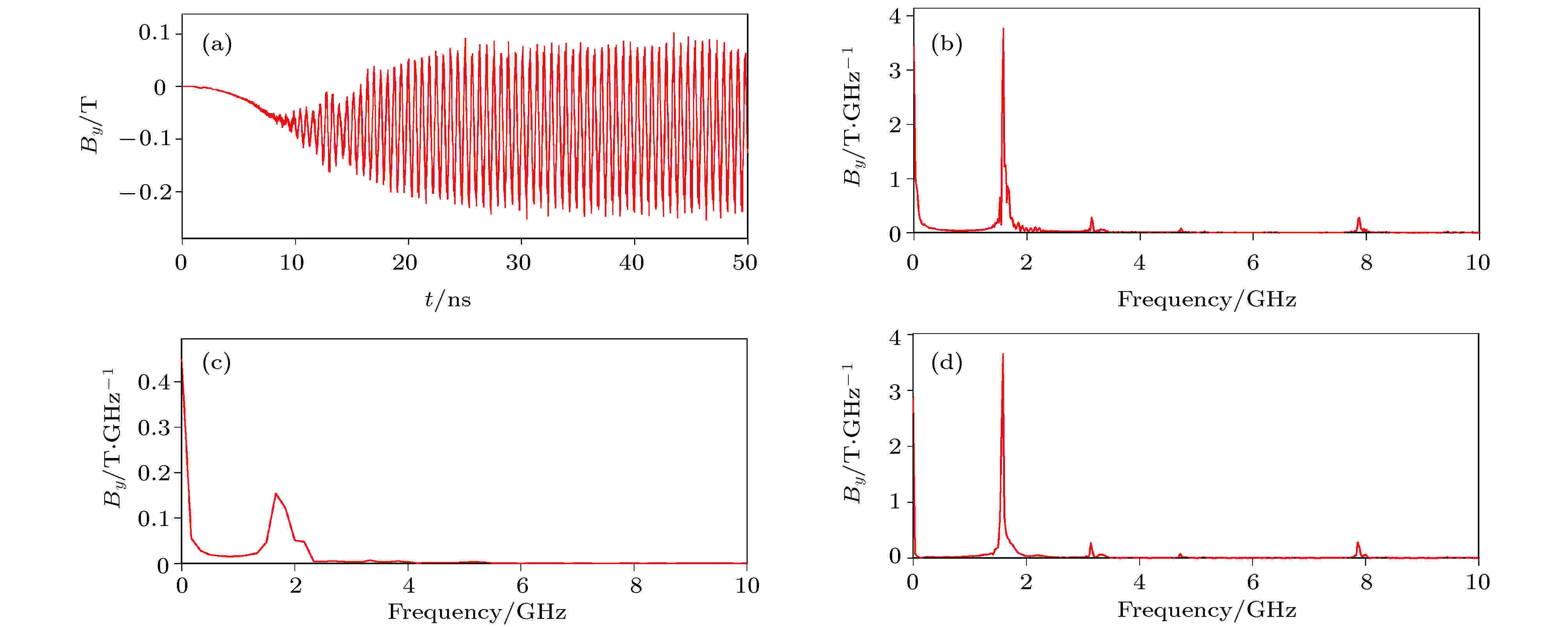 图 11 (a) 阳极腔内观察点D磁场By随时间的变化曲线及不同时间窗口(b) 0?50 ns, (c) 8?14 ns和(d) 14?50 ns的FFT变换图
图 11 (a) 阳极腔内观察点D磁场By随时间的变化曲线及不同时间窗口(b) 0?50 ns, (c) 8?14 ns和(d) 14?50 ns的FFT变换图Figure11. (a) Variations of By with time at the observation point D in the anode cavity, and the corresponding Fourier transform with different time intervals: (b) 0?50 ns, (c) 8?14 ns (d) 14?50 ns.
图12(a)—(d)给出了初始阶段不同时刻互作用区D点所在横截面轴向电场的等高图. 可以看到, 轴向电场沿角向的分布由初期的非轴对称分布, 逐渐转变为轴对称分布. 由轴向电场的分布特征和共振频率, 结合冷腔计算结果, 可以确定, 在初始阶段, 非对称模式HEM11模与TM00模产生竞争; 由于加载了电子束, 因此与冷腔分析时的结果进行比较, TM00模和HEM11模的频率由冷腔时的1.61和1.77 GHz分别降为1.6和1.7 GHz.
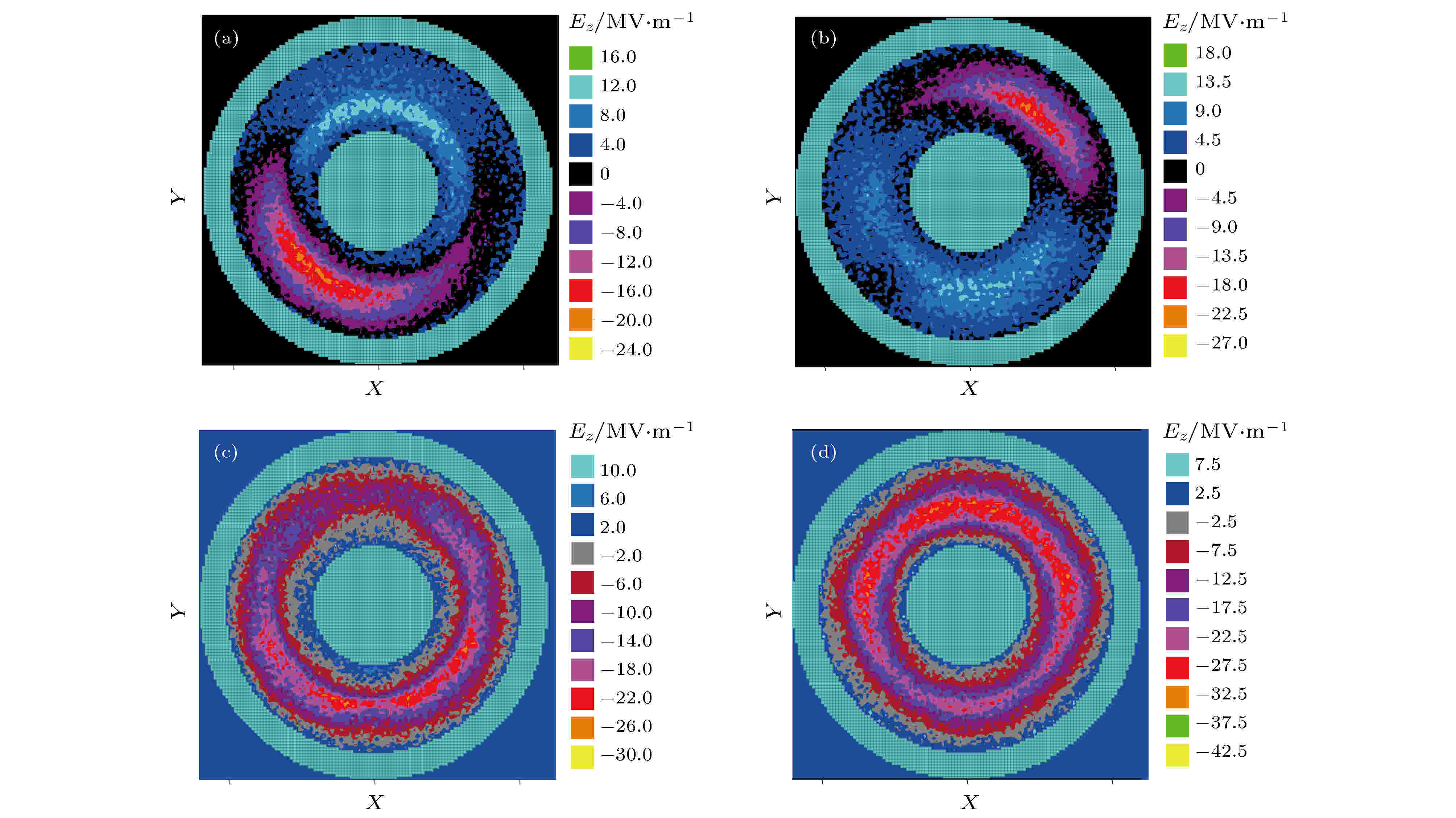 图 12 初始阶段不同时刻互作用区横截面轴向电场的等高图 (a) t = 12.171 ns; (b) t = 13.094 ns; (c) t = 14.944 ns; (d) t = 16.793 ns
图 12 初始阶段不同时刻互作用区横截面轴向电场的等高图 (a) t = 12.171 ns; (b) t = 13.094 ns; (c) t = 14.944 ns; (d) t = 16.793 nsFigure12. Contour plots of Ez in the interaction region at different times at the initial stage.
由图13(a)和图13(b)给出了饱和时互作用区中轴向电场在纵向和横向截面的等高图, 可以看到, 饱和时轴向电场在互作用区的阳极腔中正负交替排列(π模场分布), 沿角向呈轴对称分布, 与TM00模的场分布完全一致, 因此, 可以确定器件稳定后互作用区的工作模式为TM00模的π模.
 图 13 饱和时互作用区轴向电场在(a) 纵向截面和(b) 横向截面的等高图, t = 45.727 ns
图 13 饱和时互作用区轴向电场在(a) 纵向截面和(b) 横向截面的等高图, t = 45.727 nsFigure13. Contour plots of Ez in the (a) Axial and (b) radial cross section in the interaction region at saturation.
由于是在直角坐标系中建立的三维计算模型, 加上输出区还有支撑杆, 因此互作用区很难实现完全轴对称. 同时, 由于阴极电子发射面大, 电子发射也存在一定的非均匀性, 这些因素使得器件运行初期容易激发HEM11模, 且很难完全抑制. 起振一小段时间后(10 ns左右), 互作用区基模增长加快, 高阶模被抑制.
基于以上分析, 为了提高器件的输出功率和效率, 对器件的参数进行了进一步的优化, 主要调节了互作用区的周期长度和电子束电压, 其他参数保持不变. 模拟结果表明, 当周期长度p为3.1 cm, 注入的电子束的平均电压约为600 kV, 对应电功率约为45 GW时, 器件的输出效率达到了18%.
图14(a)和图14(b)给出了MILO输出周期平均功率随时间的变化曲线以及稳定后输出口电场的FFT变换图. 由图14可以看到, 饱和时输出功率高达8.1 GW, 输出频谱比较纯, 中心频率约为1.552 GHz. 由于MILO的输出区为同轴波导, 输出模式应为同轴TEM模. 图15(a)和图15(b)给出了输出口横截面电磁场分布的箭矢图, 可以看到, 计算所得的电磁场分布确与理想同轴TEM模的分布一致. 利用文献[23]给出的方法, 计算得到了模式纯度约为97%.
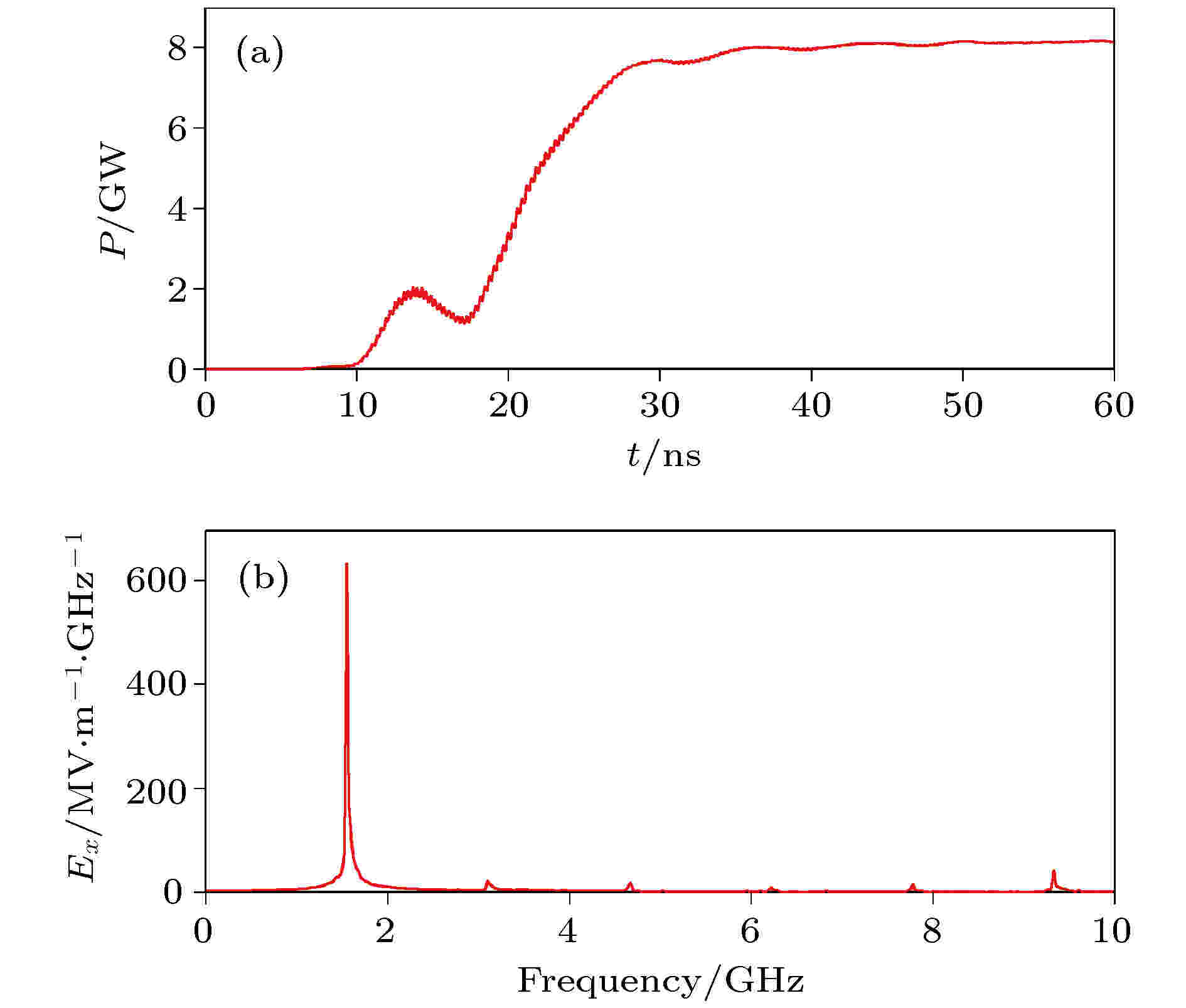 图 14 (a) MILO输出周期平均功率随时间的变化曲线; (b)稳定后输出口电场的FFT变换图
图 14 (a) MILO输出周期平均功率随时间的变化曲线; (b)稳定后输出口电场的FFT变换图Figure14. (a) Time plots of the periodic-average output power of the MILO; (b) the Fourier transform of Ex at the output port.
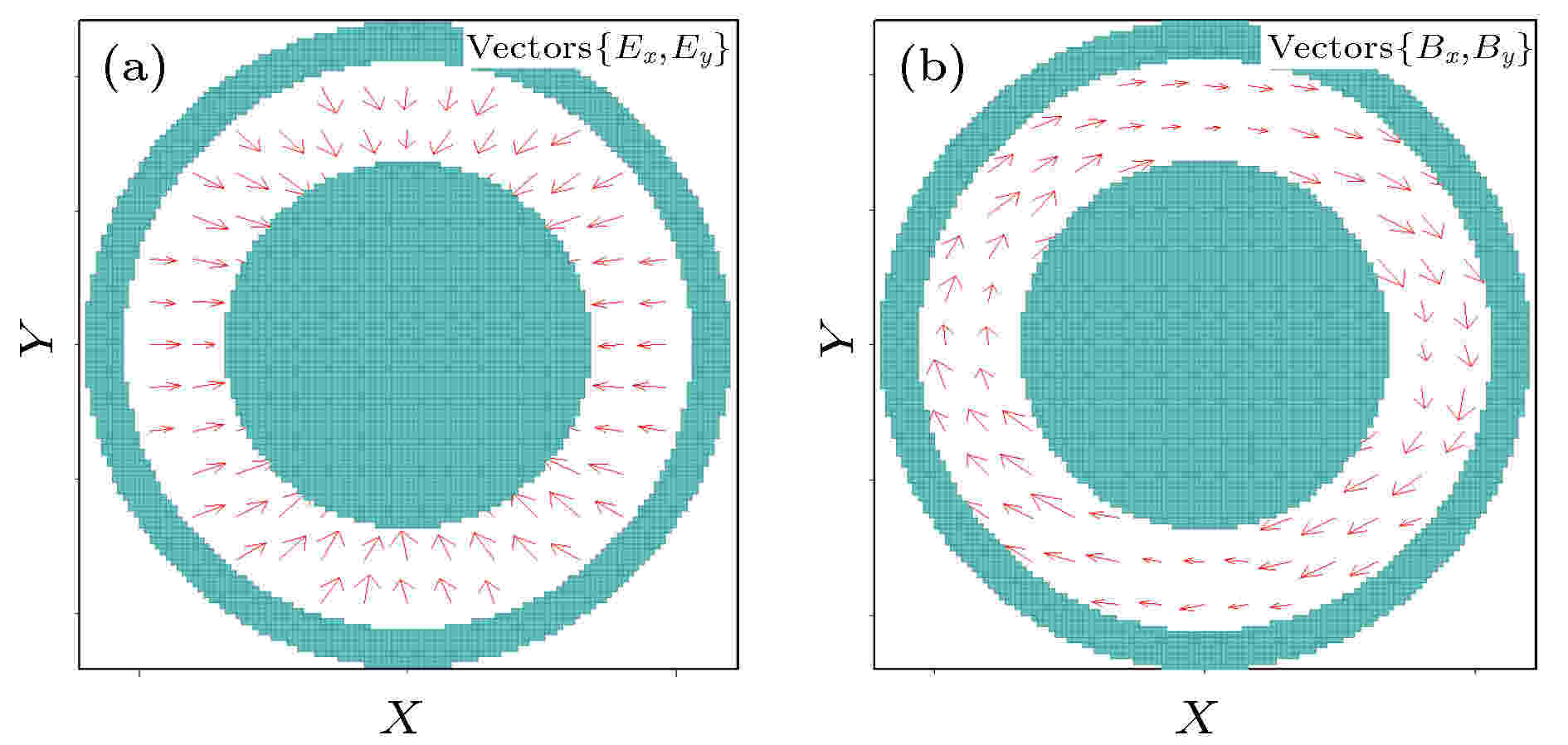 图 15 电磁场在输出口横向截面分布的箭矢图 (a) 电场; (b)磁场
图 15 电磁场在输出口横向截面分布的箭矢图 (a) 电场; (b)磁场Figure15. The vector plots of the (a) Electric field and (b) magnetic field in the radial cross section at the output port.
